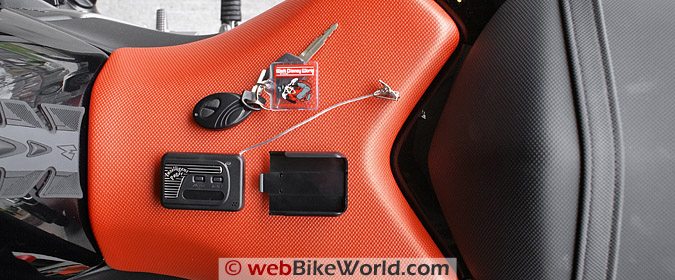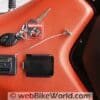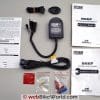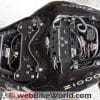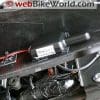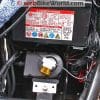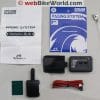A simple but very effective motorcycle alarm system.
The installed system and the optional pager works extremely well and the default settings will be just fine for many users.
Specific requirements can be addressed by changing set-up values.
This product is highly recommended and is excellent value for the money.
Motorcycle Security Systems
The Cyclone FAQ page aptly identifies and discusses what is probably one of the most burning question asked, “why do I need a motorcycle security system if my bike is fully insured?”
Well Dorothy, let me explain…
An alarm system by itself is not the total solution in preventing a motorcycle from being vandalized or stolen.
But, it can be a powerful deterrent and a key component in any layered approach to keeping your machine safe and providing some much-needed peace of mind regarding your investment.
A related tangible is that an approved security or alarm system can often lower insurance rates, sometimes significantly. However, as many individuals know when dealing with their insurance agents or brokers, ‘should’ and ‘will’ are often far apart.
Motorcycle Security System Criteria
Early motorcycle security systems were typically based on using the motorcycle horn or a very loud siren of sorts; sensing functionality was rather limited.
In many cases, a motorcycle could be efficiently lifted up on to a transport and moved away without setting off the alarm.
Thankfully, progress has been made. This progress is due to growth in the motorcycle industry, consumer awareness, technology, rising insurance costs and unfortunately, necessity.
For most motorcyclists, necessity has become the driving force, with everything else falling into line.
As motorcyclists we tend to be (very) protective of our investment(s) and as such when considering a security system of sorts, other than a thick door, a high fence or a big dog, there are basic requirements or performance criteria we look for:
- Fitment or adaptability to the motorcycle.
- Alarm or Siren type (internal and/or external with silent modes).
- Sensing features (proximity, perimeter, movement or tampering).
- Immobilizer feature (theft and insurance issues).
- Remote or paging features (away-from-motorcycle).
- Ease of use (encourages use and reduces errors).
- Reliability and safety features (always a good thing).
- Investment — purchase costs and any support fees (if applicable).
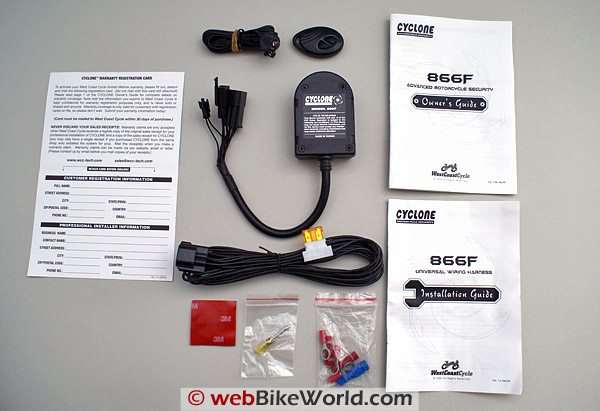
Overview
The Cyclone 866F system is engineered in Japan by Kiramek Inc and is touted to be the smallest full-featured motorcycle motorcycle security system in the world. It features a sophisticated RISC microprocessor and A/D converter.
The processor calculates bike inclination or change on two axis by reading the output of an advanced accelerometer chip.
This accelerometer has no moving parts and it is claimed to withstand shocks of up to 50,000g, making it resilient against jackhammer-like vibrations in motorcycles.
The Cyclone security system claims to set the standard for tilt sensor, reliability, accuracy and durability. The official U.S. representative of the Cyclone systems is FreyMoto Industries, formally known as West Coast Cycle LLC.
Key features of the System
- Advanced shock and tilt sensing based on a digital 2-axis tilt sensor and 2-stage shock sensor that immediately triggers the siren during theft attempts.
- Separate adjustments for 1st and 2nd shock stages, along with digital and analog filtering prevents false alarms.
- Onboard battery backup, an internal Ni-MH battery keeps Cyclone running when the main power is cut and the siren triggered.
- Starter Immobilizer — built-in in 25A relay can be used to prevent starting by severing the starter line, fuel line or magneto coil while armed.
- Auto Arm — the system automatically arms itself five minutes after the ignition is turned off, unless the system is disarmed by the rider.
- Silent Mode — mutes the full siren blast but allows Warning and Confirmation chirps
- Sleep Mode — shuts off most functions to conserve motorcycle battery power and also acts as Valet Mode.
- Panic Siren — easily activated with transmitter to warn or alert others.
- Siren — 120DB siren is distinct, user can program the siren duration of 10 or 30 seconds, or initiate a 110dB Quiet Chirp.
- Siren Trigger Memory — when disarmed the system informs you with chirps and flashes in the event that the siren was triggered in your absence.
- Sector Bypass System or SBS – prevents the siren from becoming a nuisance. Shock, tilt and ignition triggers are individually bypassed if they trigger five times — this feature can be disabled.
- Manual Disarm — allows the rider to disarm without a transmitter simply by turning the ignition key the same number of times as the ‘secret’ setup code.
- Anti-Theft LED Indicator
Optional Features
- Pager System — this feature provides a wireless and remote notification capability
- Secondary Siren — external, this second 120dB waterproof siren provides extra volume, includes an internal battery and wired remote.
- Spare Transmitter and replacement cases (black, carbon fibre, wood grain, blue metallic and Hawaiian)
- Faster Installs — Quick-Connect installation harnesses are available for many motorcycles, making installation easier than with the included Universal Harness.
Installation
With the kit sitting on the ‘pending’ shelf for part of the winter, the need and desire to get the alarm installed was always there.
But winter stayed later this year, then left in a hurry and spring never really did get sprung as summer-like conditions descended upon the region with a vengeance.
So while the really large snow-banks were still melting, shorts and t-shirts became the norm and getting out to work in the garage the first priority and first up was the Cyclone 866F alarm installation.
Included in the kit was a Quick-Connect installation harness tailored for installation on the target motorcycle, a 2007 Kawasaki Z1000.
This motorcycle seems to languish on showroom floors — a somewhat puzzling issue as it is a superb example of what can be wrought from an extremely creative “Universal Japanese Motorcycle” mind. But we digress…
To provide access to everything and properly mount the whole system, some disassembly of the Z1000 is needed.
If one is familiar with the Z1000 and its under-seat layout, removal of the necessary parts, installation of the alarm system and reassembly is quite straightforward; there’s a link to a Z1000 installation tips document in the summary table below.
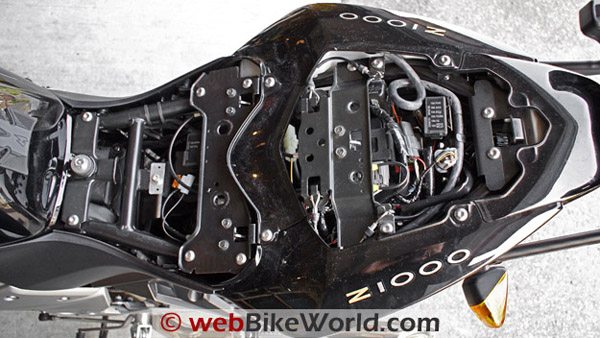
Even with its mighty power plant, the Z1000 is a small and compact motorcycle and there is not a lot of vacant real estate, except under the seat.
Thankfully, the Cyclone 866F components are small and mount up nicely in the space between the air-box intake and the battery shelf. Hopefully this location can be permanent as it provides good physical security as well.
The specific model instructions provided as part of the FreyMoto Quick-Connect package are well detailed and clear.
But the Z1000 has ‘extra’ harness connectors, some of which use the same colour-coded wiring as identified in the installation kit and as the function of some of these harnesses was not known, a time-out was taken so that access to a Kawasaki Shop Manual could be gained.
While awaiting access to the Shop Manual, Jesse Frey at FreyMoto was contacted and brought into the loop. Concerned over the situation, he suggested some viable workarounds and provided ongoing support.
His input and advice was always timely and constructive. He is a good person to deal with.
Although the time-out ended up lasting 48 hours, a thorough review of the appropriate section of the Shop Manual applicable to the U.S. and Canadian model revealed the necessary components, related harnesses and wiring codes, allowing the installation to continue.
For the target 2007 Kawasaki Z1000, the following connections were made using the supplied harness and kit installation material:
- Red lead — to positive terminal of battery using supplied end-connector.
- Black lead — to negative terminal of battery using supplied end-connector.
- Blue lead — tapped into main power lead (thick brown wire) from Fuse Box 2 (multi-fuse box at rear of under-seat area) using supplied Posi-Tap connector.
- Green and White leads — provides the switched circuit for immobilizer use. The correct Yellow/Red (Y/R) wire was located at the Relay Box that is housed as part of the Main (30A) Fuse circuit. This Y/R wire is cut and the Green and White leads connected to each half respectively using the supplied Posi-Lock connectors.
- Red and Blue wire connector — for connecting the Anti-Theft LED indicator unit.
- OOrange and Black wire connector — for connecting the optional Paging System.
NOTE: It is absolutely essential that all wiring, particularly the immobilizer leads, be correctly, securely and safely installed.
If the immobilizer connections fail, the motorcycle will not start and unless access to the connections is provided, no workaround will be possible.
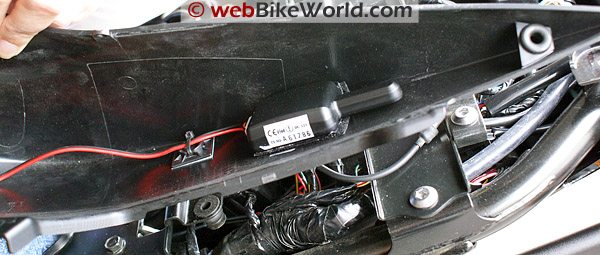
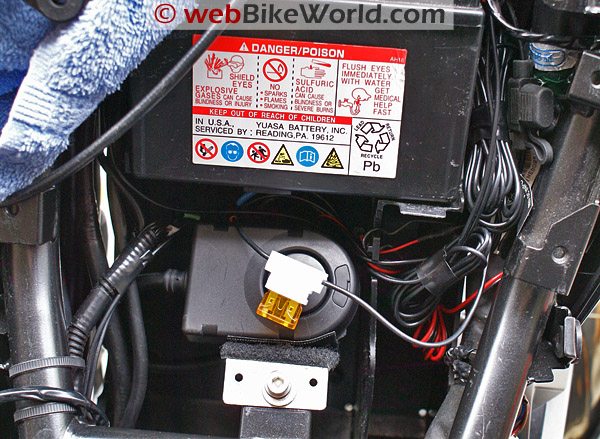
The kit includes an Anti-Theft LED indicator unit, on a long lead that is connected to the main alarm harness by a two-pin connector.
This information and warning indicator is best installed on the instrument pod or handlebar assembly for visibility, so this is where it went, after being run along the inner right side of the fuel tank (there is a clip available underneath) up to the steering head.
Following normal routine, initial connection testing was done as the installation proceeded and before everything was buttoned up the suggested system tests were conducted – all successfully. There is no mistaking the sound of that alarm!
Total work time on the alarm system was about three hours.
Life With A Cyclone
Basic functions are pretty standard. One press on either button of the single remote arms or disarms the system.
Armed mode is indicated by a single chirp and a flash of the Blue LED. Disarmed Mode is indicated by three chirps and three accompanying flashes of the Blue LED.
If the unit is not disarmed via the remote, or manually as described in the manual, the alarm system will automatically arm itself five minutes after the ignition is turned off.
With the system armed, turning on the ignition system will set off the alarm, for either 10 or 30 seconds, depending on the set-up model selected (default is 10).
If the switch is left turned on and the system not disarmed, then the alarm will sound again after 45 seconds.
If the Sector Bypass System or SBS is enabled or ON (the default setting) this cycle will be repeated up to five times and then stop – shortening the ‘nuisance’ factor.
If the SBS has not been enabled, the siren will cycle on and off an unlimited number of times as long as the ignition switch is turned on and there is power of some sort to the system.
Speaking of power, the unit backup battery is trickle charged by the main power supplied to the alarm system — when fully charged the siren should sound for up to two hours, unless interrupted and reset.
With daily use of the motorcycle and the alarm, no changes to the default settings have yet been made or needed.
The motorcycle has been purposely left out on the (main residential) street, the edge of the driveway, at favourite stops out on the road and in commercial areas that get a lot of traffic, including loud-pipe motorcycles.
The Cyclone 866F shock sensor digitally filters out “environmental vibrations” and given the ever-increasing construction traffic, it obviously works well.
The Shock Sensor has triggered the odd time as indicated by two short chirps, but not the full siren. Both the tilt and shock sensors have been activated.
Harder shocks or disturbing the motorcycle in any way, including tilting it more than three degrees, immediately triggers the alarm.
While still exploring some features, after two weeks of use the system is performing flawlessly. It is unobtrusive, virtually undetectable given mounting location and access restrictions and trouble free.
TThe Immobilizer feature really does shut everything down. When one forgets to disarm the system, there is no juice going to anything starter related until it is disarmed. Unplugging the main harness or causing power to be lost to the system in any way results in the same situation.
A Panic Siren feature, similar to that used on most automotive systems, lets the user push both buttons on the remote, and if within range, the siren will sound for 10 or 30 seconds, depending on the setting.
This is a great when you want to discourage individuals from hovering too close or attempting to sit on the motorcycle — which happens all the time in this area.
When you return to the motorcycle and disarm the system, the Siren Trigger Memory feature will inform you via chirps and LED flashes if either the sensors have been activated or the siren has actually gone off in your absence.
The Pager Option
SSatisfied with the installation and performance of the basic system, the optional Paging System was installed. The Cyclone Paging System works with the Cyclone 866F alarm to page the owner when the motorcycle alarm is triggered.
The Cyclone Paging System is connected to the Cyclone 866F motorcycle alarm with a two pin plug, thus it’s not necessary to cut the wire to splice in the pager.
The pager can be operated in “silent” mode, which allows the owner to know when the alarm has been triggered.
The pager antenna can be hidden on the motorcycle and Kiramek claims that the paging system has a 2,000 ft. or 609 m range, which is probably quite viable in open terrain.
The pager kit is comprised of the pager antenna module, a connection harness, a patch of double-sided tape, the pager itself, and a small instruction sheet.
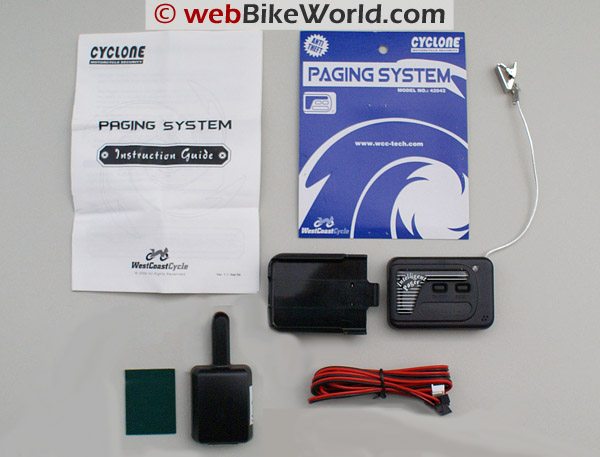
Adding this feature to the alarm system is simple. Make sure the alarm is disarmed and then plug the small (40 x 85mm or 1.5 x 3.5 in) antenna module connecting harness into the antenna module and the provided connector on the main alarm harness.
With this done, temporarily position and affix (electrical tape is good) the antenna to a spot inside the area where the alarm is mounted — a frame tube or to the inside of a side panel works well.
Once done, install the seat sections and rearm the Cyclone system.
Install two AAA batteries in the Paging Unit and push the ON/OFF button — you will hear a two-second beep verifying that the pager is on and ready to receive signals.
Push ON/OFF again and you will hear two short beeps verifying that the pager is powered off.
Turn the pager back on and walk 100 to 200 meters away from the motorcycle.
Have someone trigger the alarm — if in range, the pager will sound a repeating series of beeps and its LED will flash when the 866F is triggered, indicating a successful radio-frequency link.
This installation seems to provide a pager link out to at least 500 m or 1640 ft. It will take further use in both built-up and more open surroundings to establish a good baseline.
If the range results are really short during setup, the antenna module may need to be relocated, time and patience is needed.
When the tests have been completed and an optimum range enabled, secure the antenna module to the appropriate spot using the double-sided tape and make sure everything is re-assembled.
There are actually two clips on the pager – one on the back for use on a belt or strap and more importantly, the wire clip assembly that is actually the antenna; if it is not extended or clipped in place or if it gets damaged, pager range will be reduced, perhaps significantly.
With the pager enabled and if the siren is triggered, both beeps and LED flashes will occur.
Pushing the RESET button once will stop the beeping but the pager LED will continue to flash as long as the siren is active. Powering the pager OFF will of course stop both warnings.
With the pager option, the Silent Mode feature of the alarm system can now be used. This mode prevents the siren from being triggered although the arm and disarm chirps are still audible.
The Pager takes over as the alert mechanism — keeping you informed but without alerting those closest to the motorcycle.
Battery life should be around 30 days using standard alkaline cells.
Rechargeable NiMH cells will extend that period somewhat and reduce consumption, but lithium units will provide the best service.
Whatever battery is used, please make sure that all cells used are disposed of or recycled properly.
UPDATE (12/08): The Cyclone alarm is now RSS 210 compliant for use in Canada; see the Owner Comments section below for more information.
Conclusion
II feel that this is a very good alarm system. While not being able to yet attest to its durability over an extended period of time, the quality evident in the kit components would indicate that it is a pretty rugged piece of kit built to last.
Everything is well marked and simple to use.
Overall installation was a breeze and taking the extra time to provide a good solid mount is likely to pay dividends down the road and just knowing that its placement optimizes system effectiveness is peace of mind on its own.
As there is (probably) only one real good spot to mount the full alarm system, adding a flat or shaped bracket to the kit would put the icing on an already attractive cake.
The pager is a smart option to add.
While it does not have to be used all the time, its there when needed and when circumstances (distance) allow. The pager itself is a bit large (being spoiled by some of the mini-bordering-on-micro devices now available) but it is easily seen, secured and seems to be quite sturdy in its own right.
A good alarm system — although required for perhaps the wrong reasons — is always a good investment, whether it is installed at the factory, by a dealer, or by the user. As current alarm systems go, the Cyclone 866F is a very good investment.
And ending on another positive note, installation of this alarm system should result in a policy discount from your friendly insurance agent or broker.
And if they are not sure, push the issue.
Most alarm systems sold in the U.S. and Canada are certified and are thus eligible devices.
|
wBW Review: Cyclone 866F Motorcycle Alarm
|
|
|---|---|
| Manufacturer: Kiramek Inc. | List Price (2008): Cyclone 866F Alarm Kit – $199.99 – $229.99 USD. Cyclone Paging System – $99.99 – $229.99 USD. Cyclone Pro-Install Kit – $12.99 USD. |
| Review Date: May 2008 | Made In: Japan |
| Also: Kawasaki Z1000 Installation Tips(.pdf) | Certifications and Standards: FCC (U.S.A.) |
| Notes: Limited lifetime warranty to the original purchaser for as long as the vehicle is owned by that same purchaser and if properly installed and registered. All other parts and/or accessories are warranted for one (1) year from the original date of purchase (excluding batteries). | |
Owner Comments and Feedback
See details on submitting comments.
From SecureQuip Systems Ltd (12/08): “I was reading the review of the Cyclone 866F Motorcycle alarm and would to pass on that the Cyclone 866F is now RSS 210 compliant which allows for its use in Canada and is available through SecureQuip Systems.
The RSS 210 licensing is the Canadian equivalent to the FCC licensing in the US.
SecureQuip Systems Ltd is the exclusive importer/distributor for the Cyclone 866F Motorcycle Alarm in Canada with offices in BC and Ontario. Contact: SecureQuip Systems Ltd., 141-6200 McKay Ave., Suite 933, Burnaby, BC V5H 4M9
Cell: 604-690-4475.


